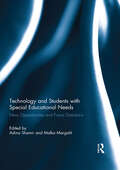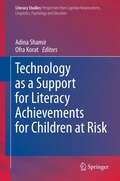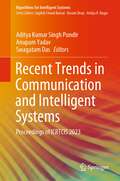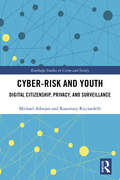- Table View
- List View
Is Artificial Intelligence Racist?: The Ethics of AI and the Future of Humanity
by Arshin Adib-MoghaddamHow did racism creep into the algorithms that govern our daily lives, from banking and shopping, to job applications? Connecting the legacy of enlightenment racism to forms of discrimination in modern day algorithms and Artificial Intelligence, this volume examines what data feeds into AI technology - and how this data will shape the future of humanity. Delving into the narratives enveloping the development of AI systems, with a particular emphasis on "tech-giants" and the ideas of Mark Zuckerberg, Elon Musk and Bill Gates, Arshin Adib-Moghaddam explains how and why technology aids and abets various forms of extremism, entrenches social hierarchies and discriminatory boundaries and how this will impact international security and human rights in the future.
Is Artificial Intelligence Racist?: The Ethics of AI and the Future of Humanity
by Arshin Adib-MoghaddamHow did racism creep into the algorithms that govern our daily lives, from banking and shopping, to job applications? Connecting the legacy of enlightenment racism to forms of discrimination in modern day algorithms and Artificial Intelligence, this volume examines what data feeds into AI technology - and how this data will shape the future of humanity. Delving into the narratives enveloping the development of AI systems, with a particular emphasis on "tech-giants" and the ideas of Mark Zuckerberg, Elon Musk and Bill Gates, Arshin Adib-Moghaddam explains how and why technology aids and abets various forms of extremism, entrenches social hierarchies and discriminatory boundaries and how this will impact international security and human rights in the future.
Innovation for Systems Information and Decision: Third Innovation for Systems Information and Decision Meeting, INSID 2021, Virtual Event, December 1–3, 2021, Proceedings (Lecture Notes in Business Information Processing #435)
by Adiel Teixeira de Almeida Danielle Costa MoraisThis book constitutes the refereed proceedings of the Third International Meeting on Innovation for Systems Information and Decision, INSID 2021, which was held during December 1-3, 2021. The conference was initially planned to take place in Recife, Brazil, but changed to a virtual meeting due to the COVID-19 pandemic. The 9 full papers presented in this volume were carefully reviewed and selected from a total of 76 submissions. They reflect methodological improvements and advances in multi-criteria decision-making/multi-criteria decision-aid (MCDM/MCDA) oriented toward real-world applications, which contribute to the understanding of relevant developments of current research on and future trends of innovation for systems information and decision.
Innovation for Systems Information and Decision: Second International Meeting, INSID 2020, Recife, Brazil, December 2–4, 2020, Proceedings (Lecture Notes in Business Information Processing #405)
by Adiel Teixeira de Almeida Danielle Costa MoraisThis book constitutes the refereed proceedings of the Second International Meeting on Innovation for Systems Information and Decision meeting, INSID 2020, held in Recife, Brazil, in December 2020. Due to the COVID-19 pandemic the conference was held virtually. The 8 papers presented in this volume were carefully reviewed and selected from a total of 84 submissions to the main conference. The selected papers reflect methodological improvements and advances in Multicriteria Decision-Making/Multicriteria Decision-Aid (MCDM/MCDA) oriented toward real-world applications and contribute to the understanding of relevant developments of current research on and future trends of Innovation for Systems Information and Decision.
Technology and Students with Special Educational Needs: New Opportunities and Future Directions
by Adina Shamir and Malka MargalitHeterogeneous classes including students with Special Educational Needs (SEN) are increasingly becoming fixtures of the twenty-first century school. As a result, the question of how to devise more effective, innovative and diverse tools has posed a significant challenge for educators and the research community. This collection considers how technology may provide SEN children with greater opportunities to acquire academic skills, while preparing them for a successful transition to adulthood. Computers, and other new technologies, hold great promise for facilitating the inclusion of SEN individuals into modern society. Precisely because they are characterized by multiple representations of knowledge, computerized learning environments offer effective support tools for the instruction of SEN students faced with barriers that make learning a more complex process. Yet, despite the blossoming of this field, research on how the use of technology may benefit SEN students is in its early stages. The development of the theoretical knowledge and empirical databases necessary to assess the impact of computers on learners’ characteristics and educators' teaching goals lag behind the introduction of the respective technological innovations. To meet this challenge, this volume presents a review of the latest advances in how new technologies and their software may potentially enhance SEN students' performance, in school and out. This book was originally published as a special issue of the European Journal of Special Needs.
Technology as a Support for Literacy Achievements for Children at Risk (Literacy Studies #7)
by Adina Shamir and Ofra KoratPresenting cutting-edge studies from various countries into the theoretical and practical issues surrounding the literacy acquisition of at-risk children, this volume focuses specifically on the utility of technology in supporting and advancing literacy among the relevant populations. These include a range of at-risk groups such as those with learning disabilities, low socioeconomic status, and minority ethnicity. Arguing that literacy is a key requirement for integration into any modern society, the book outlines new ways in which educators and researchers can overcome the difficulties faced by children in these at-risk groups. It also reflects the rapid development of technology in this field, which in turn necessitates the accumulation of fresh research evidence.
Recent Trends in Communication and Intelligent Systems: Proceedings of ICRTCIS 2020 (Algorithms for Intelligent Systems)
by Aditya Kumar Singh Pundir Anupam Yadav Swagatam DasThis book presents best selected research papers presented at the International Conference on Recent Trends in Communication and Intelligent Systems (ICRTCIS 2020), organized by Arya College of Engineering and IT, Jaipur, on 20-21 November 2020. It discusses the latest technologies in communication and intelligent systems, covering various areas of communication engineering, such as signal processing, VLSI design, embedded systems, wireless communications, and electronics and communications in general. Featuring work by leading researchers and technocrats, the book serves as a valuable reference resource for young researchers and academics as well as practitioners in industry.
Recent Trends in Communication and Intelligent Systems: Proceedings of ICRTCIS 2023 (Algorithms for Intelligent Systems)
by Aditya Kumar Singh Pundir Anupam Yadav Swagatam DasThe book presents best selected research papers presented at the Fourth International Conference on Recent Trends in Communication and Intelligent Systems (ICRTCIS 2023), organized by Arya College of Engineering and IT, Jaipur, on April 28–29, 2023. It discusses the latest technologies in communication and intelligent systems, covering various areas of communication engineering, such as signal processing, VLSI design, embedded systems, wireless communications, and electronics and communications in general. Featuring work by leading researchers and technocrats, the book serves as a valuable reference resource for young researchers and academics as well as practitioners in industry.
Recent Trends in Communication and Intelligent Systems: Proceedings of ICRTCIS 2021 (Algorithms for Intelligent Systems)
by Aditya Kumar Singh Pundir Neha Yadav Harish Sharma Swagatam DasThis book presents best selected research papers presented at the Third International Conference on Recent Trends in Communication and Intelligent Systems (ICRTCIS 2021), organized by Arya College of Engineering and IT, Jaipur, on 22-23 October 2021. It discusses the latest technologies in communication and intelligent systems, covering various areas of communication engineering, such as signal processing, VLSI design, embedded systems, wireless communications, and electronics and communications in general. Featuring work by leading researchers and technocrats, the book serves as a valuable reference resource for young researchers and academics as well as practitioners in industry.
The Burrows-Wheeler Transform: Data Compression, Suffix Arrays, and Pattern Matching
by Donald Adjeroh Timothy Bell Amar MukherjeeThe Burrows-Wheeler Transform is one of the best lossless compression me- ods available. It is an intriguing — even puzzling — approach to squeezing redundancy out of data, it has an interesting history, and it has applications well beyond its original purpose as a compression method. It is a relatively late addition to the compression canon, and hence our motivation to write this book, looking at the method in detail, bringing together the threads that led to its discovery and development, and speculating on what future ideas might grow out of it. The book is aimed at a wide audience, ranging from those interested in learning a little more than the short descriptions of the BWT given in st- dard texts, through to those whose research is building on what we know about compression and pattern matching. The ?rst few chapters are a careful description suitable for readers with an elementary computer science ba- ground (and these chapters have been used in undergraduate courses), but later chapters collect a wide range of detailed developments, some of which are built on advanced concepts from a range of computer science topics (for example, some of the advanced material has been used in a graduate c- puter science course in string algorithms). Some of the later explanations require some mathematical sophistication, but most should be accessible to those with a broad background in computer science.
OpenStack Cloud Application Development
by Scott Adkins John Belamaric Vincent Giersch Denys Makogon Jason E. RobinsonLeverage the power of OpenStack to develop scalable applications with no vendor lock-in OpenStack Cloud Application Development is a fast-paced, professional book for OpenStack developers, delivering comprehensive guidance without wasting time on development fundamentals. Written by experts in the OpenStack community from Infoblox, Gigaspaces, GoDaddy, and Comcast, this book shows you how to work effectively and efficiently within the OpenStack platform to develop large, scalable applications without worrying about underlying hardware. Follow along with an OpenStack build that illustrates how and where each technology comes into play, as you learn expert tips and best practices that make your product stronger. Coverage includes OpenStack service primitives, networking within the OpenStack Ecosystem, deployment of Virtualized Network Functions for Enterprises, containers, data protection, and much more. If you need to get on board quickly, this professional book is your ideal roadmap to OpenStack development. Understand all aspects of OpenStack technologies Follow an example build to drill down into critical elements Learn the OpenStack best practices and insider tips Leverage the full capability of IaaS at a professional pace OpenStack is supported by dozens of major technology companies, compatible with Amazon Web Services, and can be used alongside or on top of VMWare vSphere and other similar technologies. It frees developers from the confines of hardware and vendor lock-in while providing a reliable, fast, and easy platform for developing scalable cloud applications. OpenStack Cloud Application Development is an expert-led guide to getting the most out of OpenStack, designed specifically for the professional developer.
OpenStack Cloud Application Development
by Scott Adkins John Belamaric Vincent Giersch Denys Makogon Jason E. RobinsonLeverage the power of OpenStack to develop scalable applications with no vendor lock-in OpenStack Cloud Application Development is a fast-paced, professional book for OpenStack developers, delivering comprehensive guidance without wasting time on development fundamentals. Written by experts in the OpenStack community from Infoblox, Gigaspaces, GoDaddy, and Comcast, this book shows you how to work effectively and efficiently within the OpenStack platform to develop large, scalable applications without worrying about underlying hardware. Follow along with an OpenStack build that illustrates how and where each technology comes into play, as you learn expert tips and best practices that make your product stronger. Coverage includes OpenStack service primitives, networking within the OpenStack Ecosystem, deployment of Virtualized Network Functions for Enterprises, containers, data protection, and much more. If you need to get on board quickly, this professional book is your ideal roadmap to OpenStack development. Understand all aspects of OpenStack technologies Follow an example build to drill down into critical elements Learn the OpenStack best practices and insider tips Leverage the full capability of IaaS at a professional pace OpenStack is supported by dozens of major technology companies, compatible with Amazon Web Services, and can be used alongside or on top of VMWare vSphere and other similar technologies. It frees developers from the confines of hardware and vendor lock-in while providing a reliable, fast, and easy platform for developing scalable cloud applications. OpenStack Cloud Application Development is an expert-led guide to getting the most out of OpenStack, designed specifically for the professional developer.
IBM Cognos Business Intelligence
by Dustin AdkisonWritten as a practical guide, this book will show you how to manage your reporting environment using IBM Cognos 10 and make the most out of BI tools within your business - taking a hands-on approach to stimulate learning and develop your understanding. If you are an IBM Cognos or Business Intelligence developer or consultant, have a basic knowledge of Cognos 10 BI and a good level of understanding of Cognos 8 then this book is for you.
Primality Testing and Abelian Varieties Over Finite Fields (Lecture Notes in Mathematics #1512)
by Leonard M. Adleman Ming-Deh A. HuangFrom Gauss to G|del, mathematicians have sought an efficient algorithm to distinguish prime numbers from composite numbers. This book presents a random polynomial time algorithm for the problem. The methods used are from arithmetic algebraic geometry, algebraic number theory and analyticnumber theory. In particular, the theory of two dimensional Abelian varieties over finite fields is developed. The book will be of interest to both researchers and graduate students in number theory and theoretical computer science.
Graph-Theoretic Concepts in Computer Science: 46th International Workshop, WG 2020, Leeds, UK, June 24–26, 2020, Revised Selected Papers (Lecture Notes in Computer Science #12301)
by Isolde Adler Haiko MüllerThis book constitutes the revised papers of the 46th International Workshop on Graph-Theoretic Concepts in Computer Science, WG 2020, held in Leeds, UK, in June 2020. The workshop was held virtually due to the COVID-19 pandemic. The 32 full papers presented in this volume were carefully reviewed and selected from 94 submissions. They cover a wide range of areas, aiming to present emerging research results and to identify and explore directions of future research of concepts on graph theory and how they can be applied to various areas in computer science.
Usability: Turning Technologies into Tools
by Paul S. Adler Terry A. WinogradAs more and more equipment incorporates advanced technologies, usability -- the ability of equipment to take advantage of users' skills and thereby to function effectively in the broad range of real work situations -- is becoming an essential component of equipment design. Usability: Turning Technologies into Tools collects six essays that herald a fundamental shift in the way industry and researchers think about usability. In this new, broader definition, usability no longer means safeguarding against human error, but rather enabling human beings to learn, to use, and to adapt the equipment to satisfy better the demands and contingencies of their work. Following an introduction that develops some core concepts of usability, the subsequent chapters: -- describe the role of usability in guiding one of Xerox's largest strategic initiatives -- analyze a Monsanto chemical plant where a study of worker's conversational patterns contributed to the design of a more effective system of controls -- present an empirical study of equipment design practices in U.S. industry which contrasts technology-centered and skill-based design approaches -- summarize recent Scandinavian experiences with user participation in design, with specific reference to the DEMOS and UTOPIA projects -- analyze European experiences that suggest five key criteria for effective human-centered design of advanced manufacturing technology --offer an insightful discussion of the powerful, often hidden human and organizational resources that conventional design processes overlook. Today, three quarters of all advanced technology implementations in manufacturing fail to achieve their performance goals because of inadequate usability. By viewing the human being as a mechanistic system component, and not a particularly reliable one, the traditional "human factors" model of usability virtually ensures that the uniquely human qualities -- experience, adaptation, innovation -- will be neglected, and therefore that new technologies will realize little of their true potential. Usability: Turning Technologies into Tools answers the need for better usability criteria and more effective design and usability assurance processes. In so doing, it leads the way to making a new, broader concept of usability central to design. Its chapters will be of interest to managers and professionals in computer systems, manufacturing engineering, industrial design, and human factors, as well as researchers in disciplines such as computer science, engineering, design studies, sociology, organizational behavior and human resource management, industrial relations, education, and business strategy.
Dependable Computing - EDCC 2021 Workshops: DREAMS, DSOGRI, SERENE 2021, Munich, Germany, September 13, 2021, Proceedings (Communications in Computer and Information Science #1462)
by Rasmus Adler Amel Bennaceur Simon Burton Amleto Di Salle Nicola Nostro Rasmus Løvenstein Olsen Selma Saidi Philipp Schleiss Daniel Schneider Hans-Peter SchwefelThis book constitutes refereed proceedings of the Workshops of the 17th European Dependable Computing Conference, EDCC: Second Worskhop on Dynamic Risk Management for Autonomous Systems, DREAMS 2021, Third Workshop on Dependable Solutions for Intelligent Electricity Distribution Grids, DSOGRI 2021, 13th Workshop on Software Engineering for Resilient Systems, SERENE 2021, held in September 2021. Due to the COVID-19 pandemic the workshops were held virtually. The 14 workshop papers presented were thoroughly reviewed and selected from 22 submissions. The workshop papers complement the main conference topics by addressing dependability or security issues in specic application domains or by focussing in specialized topics, such as system resilience.
The Essential Persona Lifecycle: Your Guide to Building and Using Personas
by Tamara Adlin John PruittThe Essential Persona Lifecycle: Your Guide to Building and Using Personas offers a practical guide to the creation and use of personas, which can help product designers, their team, and their organization become more user focused. This book is for people who just need to know what to do and what order to do it in. It is completely focused on practical tools and methods, without much explanation on why the particular tool or method is the right one. The book discusses the five phases of persona lifecycle: Family planning — Basic ideas and a few tools that will help one get organizedConception and gestation — Step-by-step instructions to move from assumptions to completed personasBirth and maturation — Strategic techniques to get the right information about ones personas out to ones your teammates at the right timeAdulthood — Specific tools that will ensure that ones personas are used by the right people at the right times and in the right ways during the product development cycleLifetime achievement and retirement — Basic ideas and a few tools to you measure the success of the persona effort and prepare for the next onePractical and immediately applicable how-to reference guide for building and using personas – from planning, creating, launching, evaluating, and determining ROIInvaluable guide that gives you a quick reference for incorporating personas into a product development processFeatures all the essential how-to material from its parent book, The Persona Lifecycle, as a quick, at your fingertips companion
The Persona Lifecycle: Keeping People in Mind Throughout Product Design (Interactive Technologies)
by Tamara Adlin John PruittThe Persona Lifecycle is a field guide exclusively focused on interaction design's most popular new technique. The Persona Lifecycle addresses the "how" of creating effective personas and using those personas to design products that people love. It doesn’t just describe the value of personas; it offers detailed techniques and tools related to planning, creating, communicating, and using personas to create great product designs. Moreover, it provides rich examples, samples, and illustrations to imitate and model. Perhaps most importantly, it positions personas not as a panacea, but as a method used to complement other user-centered design (UCD) techniques including scenario-based design, cognitive walkthroughs and user testing. The authors developed the Persona Lifecycle model to communicate the value and practical application of personas to product design and development professionals. This book explores the complete lifecycle of personas, to guide the designer at each stage of product development. It includes a running case study with rich examples and samples that demonstrate how personas can be used in building a product end-to-end. It also presents recommended best practices in techniques, tools, and innovative methods and contains hundreds of relevant stories, commentary, opinions, and case studies from user experience professionals across a variety of domains and industries. This book will be a valuable resource for UCD professionals, including usability practitioners, interaction designers, technical writers, and program managers; programmers/developers who act as the interaction designers for software; and those professionals who work with developers and designers.Features* Presentation and discussion of the complete lifecycle of personas, to guide the designer at each stage of product development.* A running case study with rich examples and samples that demonstrate how personas can be used in building a product end-to-end. * Recommended best practices in techniques, tools, and innovative methods.* Hundreds of relevant stories, commentary, opinions, and case studies from user experience professionals across a variety of domains and industries.
Business Computing (Handbooks in Information Systems #3)
by Gediminas Adomavicius Alok GuptaThis book is broadly organized in three parts. The first section ('Enhancing and Managing Customer Value') focuses on presenting the state-of-knowledge in managing and enhancing customer value through extraction of consumer-centric knowledge from mountains of data that modern interactive applications generate. The extracted information can then be used to provide more personalized information to customers, provide more relevant information or products, and even to create innovative business processes to enhance overall value to customers. The second section in the book ('Computational Approaches for Business Processes') focuses on presenting several specific innovative computing artifacts and tools developed by researchers that are not yet commercially used. These represent cutting-edge thought and advances in business computing research that should soon find utility in real-world applications or as a tool to analyze real-world scenarios. The final section in the book ('Supporting Knowledge Enterprise') presents approaches and frameworks that focus on ability of an enterprise to analyze, build, and protect computing infrastructure that supports value-added dimensions to the enterprise's existing business processes.
Cyber-risk and Youth: Digital Citizenship, Privacy and Surveillance (Routledge Studies in Crime and Society)
by Michael C Adorjan Rosemary RicciardelliCyber-risks are moving targets and societal responses to combat cyber-victimization are often met by the distrust of young people. Drawing on original research, this book explores how young people define, perceive, and experience cyber-risks, how they respond to both the messages they are receiving from society regarding their safety online, and the various strategies and practices employed by society in regulating their online access and activities. This book complements existing quantitative examinations of cyberbullying assessing its extent and frequency, but also aims to critique and extend knowledge of how cyber-risks such as cyberbullying are perceived and responded to. Following a discussion of their methodology and their experiences of conducting research with teens, the authors discuss the social network services that teens are using and what they find appealing about them, and address teens’ experiences with and views towards parental and school-based surveillance. The authors then turn directly to areas of concern expressed by their participants, such as relational aggression, cyberhacking, privacy, and privacy management, as well as sexting. The authors conclude by making recommendations for policy makers, educators and teens – not only by drawing from their own theoretical and sociological interpretations of their findings, but also from the responses and recommendations given by their participants about going online and tackling cyber-risk. One of the first texts to explore how young people respond to attempts to regulate online activity, this book will be key reading for those involved in research and study surrounding youth crime, cybercrime, youth culture, media and crime, and victimology – and will inform those interested in addressing youth safety online how to best approach what is often perceived as a sensitive and volatile social problem.
Cyber-risk and Youth: Digital Citizenship, Privacy and Surveillance (Routledge Studies in Crime and Society)
by Michael C Adorjan Rosemary RicciardelliCyber-risks are moving targets and societal responses to combat cyber-victimization are often met by the distrust of young people. Drawing on original research, this book explores how young people define, perceive, and experience cyber-risks, how they respond to both the messages they are receiving from society regarding their safety online, and the various strategies and practices employed by society in regulating their online access and activities. This book complements existing quantitative examinations of cyberbullying assessing its extent and frequency, but also aims to critique and extend knowledge of how cyber-risks such as cyberbullying are perceived and responded to. Following a discussion of their methodology and their experiences of conducting research with teens, the authors discuss the social network services that teens are using and what they find appealing about them, and address teens’ experiences with and views towards parental and school-based surveillance. The authors then turn directly to areas of concern expressed by their participants, such as relational aggression, cyberhacking, privacy, and privacy management, as well as sexting. The authors conclude by making recommendations for policy makers, educators and teens – not only by drawing from their own theoretical and sociological interpretations of their findings, but also from the responses and recommendations given by their participants about going online and tackling cyber-risk. One of the first texts to explore how young people respond to attempts to regulate online activity, this book will be key reading for those involved in research and study surrounding youth crime, cybercrime, youth culture, media and crime, and victimology – and will inform those interested in addressing youth safety online how to best approach what is often perceived as a sensitive and volatile social problem.
Autonomous Vehicle Navigation: From Behavioral to Hybrid Multi-Controller Architectures
by Lounis AdouaneImprove the Safety, Flexibility, and Reliability of Autonomous Navigation in Complex EnvironmentsAutonomous Vehicle Navigation: From Behavioral to Hybrid Multi-Controller Architectures explores the use of multi-controller architectures in fully autonomous robot navigation-even in highly dynamic and cluttered environments. Accessible to researchers
Autonomous Vehicle Navigation: From Behavioral to Hybrid Multi-Controller Architectures
by Lounis AdouaneImprove the Safety, Flexibility, and Reliability of Autonomous Navigation in Complex EnvironmentsAutonomous Vehicle Navigation: From Behavioral to Hybrid Multi-Controller Architectures explores the use of multi-controller architectures in fully autonomous robot navigation-even in highly dynamic and cluttered environments. Accessible to researchers
Grammatical Inference: 6th International Colloquium: ICGI 2002, Amsterdam, The Netherlands, September 23-25, 2002. Proceedings (Lecture Notes in Computer Science #2484)
by Pieter Adriaans Henning Fernau Menno Van ZaanenThe Sixth International Colloquium on Grammatical Inference (ICGI2002) was held in Amsterdam on September 23-25th, 2002. ICGI2002 was the sixth in a series of successful biennial international conferenceson the area of grammatical inference. Previous meetings were held in Essex, U.K.; Alicante, Spain; Mo- pellier, France; Ames, Iowa, USA; Lisbon, Portugal. This series of meetings seeks to provide a forum for the presentation and discussion of original research on all aspects of grammatical inference. Gr- matical inference, the process of inferring grammars from given data, is a ?eld that not only is challenging from a purely scienti?c standpoint but also ?nds many applications in real-world problems. Despite the fact that grammatical inference addresses problems in a re- tively narrow area, it uses techniques from many domains, and is positioned at the intersection of a number of di?erent disciplines. Researchers in grammatical inference come from ?elds as diverse as machine learning, theoretical computer science, computational linguistics, pattern recognition, and arti?cial neural n- works. From a practical standpoint, applications in areas like natural language - quisition, computational biology, structural pattern recognition, information - trieval, text processing, data compression and adaptive intelligent agents have either been demonstrated or proposed in the literature. The technical program included the presentation of 23 accepted papers (out of 41 submitted). Moreover, for the ?rst time a software presentation was or- nized at ICGI. Short descriptions of the corresponding software are included in these proceedings, too.




















